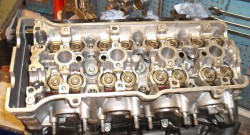 Finally, I was getting to the root of the problem. And, indeed, demonstrating that it really was a problem. First thing, though, was to close up the top of the engine. So, I took off all the cams and drive gubbins, put the followers somewhere neat and tidy and put the cam cover back on. All this so I I could up-end the engine without the followers falling out. What’s more, with the cams out I can twizzle the crank around as I want without worrying about the pistons bashing into any valves.
Finally, I was getting to the root of the problem. And, indeed, demonstrating that it really was a problem. First thing, though, was to close up the top of the engine. So, I took off all the cams and drive gubbins, put the followers somewhere neat and tidy and put the cam cover back on. All this so I I could up-end the engine without the followers falling out. What’s more, with the cams out I can twizzle the crank around as I want without worrying about the pistons bashing into any valves.
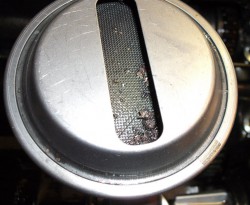 With that I took off a couple of bolts in the top of the engine, as the manual says, and turned it upside down. I then spent half an hour wondering where the bolts that fell on the bench had come from before I remembered that I’d left one of the starter motor bolts loose when I’d disconnected the earth connection.
With that I took off a couple of bolts in the top of the engine, as the manual says, and turned it upside down. I then spent half an hour wondering where the bolts that fell on the bench had come from before I remembered that I’d left one of the starter motor bolts loose when I’d disconnected the earth connection.
With that done, I removed the sump and was immediately exposed to this collection of bits and pieces in the oil pickup. Those bits look like pieces of bearing to me, so at least I felt vindicated that I’d pulled out of the Birkett with good cause.
I pressed on and split the crankcase. (A simple few words to say, but something that involved much pushing and shoving. I’ve never actually taken an engine that used stretch bolts apart before and they feel clearly different as you undo them. Problem is, they’re about £4 each and there’s a grand total of 18 of them in the main and big end bearings.
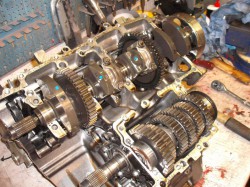 With the crankcase split everything looks ok-ish, although all that bearing swarf must have come from somewhere. When you split the crankcase you separate the main bearing and they did look OK. The mains, though, are nearer the oil pump than the big ends which are fed via the mains by drillings in the crank.
With the crankcase split everything looks ok-ish, although all that bearing swarf must have come from somewhere. When you split the crankcase you separate the main bearing and they did look OK. The mains, though, are nearer the oil pump than the big ends which are fed via the mains by drillings in the crank.
So, I had to get the big ends off. And, indeed, when I started looking it was obvious that there was something odd here. In fact, even before I’d undone the big end bolts it was clear that there was a huge amount of play in the number 3 bearing, which was where I started. There seemed to be about 1mm of play which is very slightly more than the 0.03mm specified in the manual.
I took off all the big end bearings and it looks as though #2 and #3 have suffered badly. Those bearings have clearly been picked up and spun around by the crank. The photo here shows the big end bearings from cylinders 4 (on the left) and 3 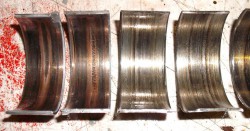 (on the right). You can see that the little locating lugs on the #4 bearings have been flattened in the #3 bearings and, if you look hard, you can see that the #3 bearings are actually wider than the #4 ones. I guess this is because as the crank battered them they spread out sideways. It’s hard to see how they can have grown as much as they have, but obviously they managed it somehow.
(on the right). You can see that the little locating lugs on the #4 bearings have been flattened in the #3 bearings and, if you look hard, you can see that the #3 bearings are actually wider than the #4 ones. I guess this is because as the crank battered them they spread out sideways. It’s hard to see how they can have grown as much as they have, but obviously they managed it somehow.
So, with the source of the problem identified I can now buy some new bits, although I could do with finding a larger micrometer to check the ovality of the big end journals. (My micrometer only goes to 25mm which isn’t big enough.) In the meantime, I stripped the oil pump to 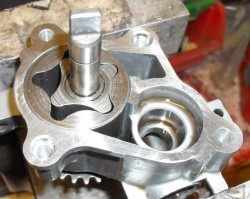 check it was OK and, happily, it all looks fine. So, hopefully, it hasn’t whizzed bits all round the engine.
check it was OK and, happily, it all looks fine. So, hopefully, it hasn’t whizzed bits all round the engine.
But, what concerns me is whether the crank has survived. It looks OK, but I can’t be sure. I’ll get Andy to have a look at it and tell me. Not sure what I’ll do if it is no good though, a new crank is £1337 + VAT!, be cheaper to find a new engine… Hopefully, I need to get a pile of new bits, have a mammoth cleaning session, and put everything back together. It could be worse though…

Not having a lot of luck Tim. So you think the oil cooler line failure caused this?
I’m sure it did. What’s more, it wasn’t the line, it was the cooler itself… We reckon that someone has changed the quality of coolers. There have been something like 10 cooler failures in RGB this year. People have started fitting heavy duty ones…
T
Yours was a Mocal cooler, wasn’t it? Do you know if the others which failed were also Mocal? I was looking at a Goodridge cooler recently – more expensive, it appears, but they do seem nicely made.
Well, it was “mocal pattern”, but all of them seem to be identical. Apparently some people are using heavy duty ones to reduce the chances of this…
I have a Setrab which seems good. I think those Scandinavians are probably pretty conservative. Shims posted Saturday.
When I do engine rebuilds I recycle the head gaskets and begrudge the cost of the oil. Don’t think I am ready for the 21st century world of stretch bolts. Good luck with getting it back together and oil tight.
Matt